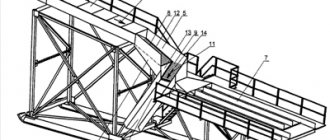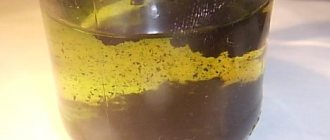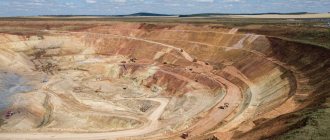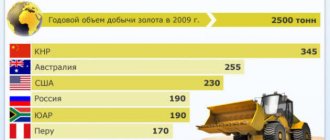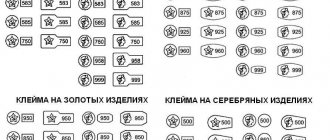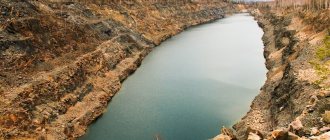For centuries, gold was considered the most valuable noble metal, which played a key role in a wide variety of areas of human activity.
But if in ancient times there were no specific methods for extracting this material, in addition to developing mines, then today things are much better and it is possible to extract a certain amount of gold from stone.
general information
Modern science knows which stones contain gold, so there are practically no difficulties with its extraction. Particles of precious metal are present in the veins of various rocks, and advanced technologies make it possible to determine their authenticity, as well as distinguish them from other, worthless materials.
In nature, gold can be found in the following forms:
- Nuggets.
- Fine-grained placers.
- Powder dust.
It is found in veins of stones and rocks, which are located in mountain rivers, among rocks and mountains, in sea sand, and also together with other minerals. Knowing which stones contain gold, you can remove it without much difficulty. The extraction of precious metal occurs through refining.
Before you start extracting it, you need to make sure that it is really a precious metal and not iron pyrite or zinc. Many minerals resemble yellow treasure with their characteristic shine, but they crumble very quickly under mechanical stress. As for gold-containing stones, they only scratch.
Fake gold sands and placers may look identical to pure gold, but they differ from it in a number of properties. The satellites of gold are intrusive rocks that were formed due to the solidification of magma.
Among them:
- Quartz diorites.
- Granite.
- Quartz.
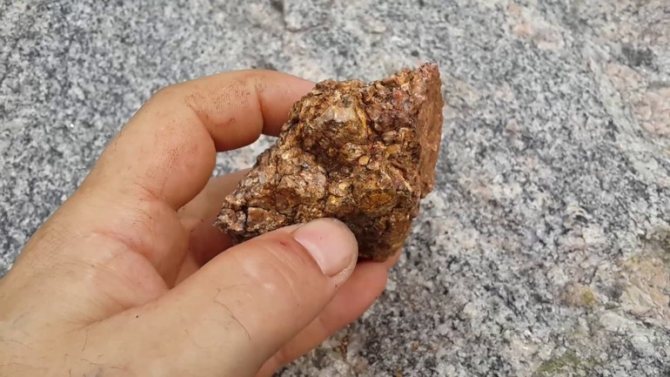
The closest neighbors of the yellow metal are galerites, pyrites, stibnites, arsenopyrites and other similar minerals. Removing a valuable find from granite is incredibly difficult; this requires complex installations and professional equipment.
When figuring out how to extract gold from stone at home, you need to understand that mining methods may differ depending on its composition and other features. To accomplish this task, a lot of chemical methods are used. When processing lead sulfite, a mechanical action is carried out, which allows you to break the stone into small cubes, and then get the desired find from there.
Quartz diorites and quartz also have an impressive content of precious metal. They can be found in rocks, rivers and rocks, as well as in sea sand and on the pebbles of the bottom of various natural bodies of water. Tiny metal particles look like gold deposits.
How accurately does the bar determine the sample?
Experts consider this method to be quite accurate and acceptable for determining the sample of precious metals. The inaccuracy in determining the sample of gold items using this method does not exceed 0.3%. In fact, the deviation is no more than 3 units, that is, a product of 582 samples will never be defined as 375.
When testing platinum and palladium, the inaccuracy is approximately similar to gold. This method works problematically with silver alloys. In this case, the discrepancy between the results exceeds 5%. Therefore, jewelers do not actually use this method to determine the quality of silver products.
The method of determining the quality of precious metals using a touchstone is an effective, fast and non-destructive method. The bars are sold in sufficient quantities in retail chains at prices ranging from 300 to 500 rubles, and a set of 6 standard needles will be sufficient for various types of control for many years.
Search for gold
How to find rock that may contain valuable yellow metal is not difficult to understand. The gold mining industry is developing in several countries where natural deposits of this rock are located. Among them:
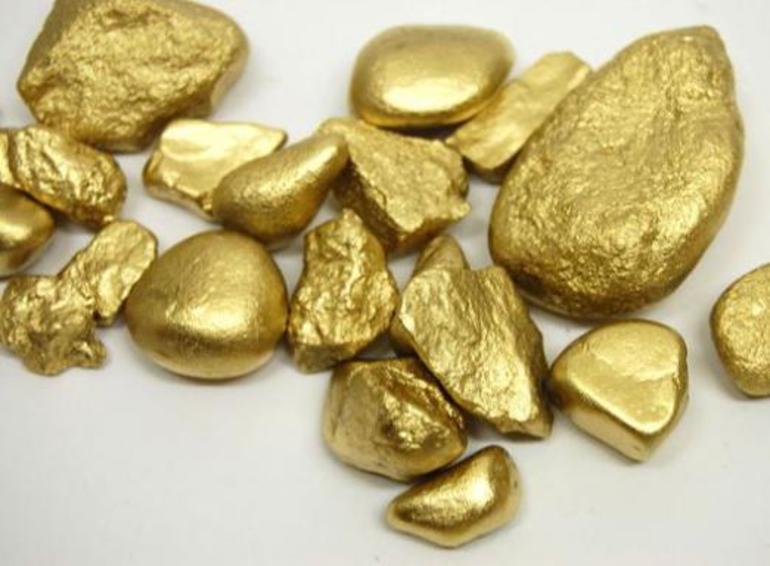
- China, which ranks first in terms of gold mining volumes.
- Australia.
- Russian Federation.
- USA.
- Canada.
- SOUTH AFRICA.
- And some other countries where gold mining is carried out on a smaller scale.
Russia is in third place on the list, behind China and Australia in terms of precious metal production. Several deposits were found on the territory of the state, 95% of which are located in the regions of the Far East, in the Amur, Krasnoyarsk and Irkutsk regions, as well as in Chukotka. Gold is also mined in Buryatia, Transbaikalia, Khabarovsk and Krasnoyarsk territories. The latter region is considered the leader in terms of volumes of precious metal extraction from the ground.
Identification of deposits in nature
In the era of free access to any information, it is not difficult to understand how to identify gold in a stone. But before that, you need to consider the list of the most promising places in which such a metal is likely to be present. Theoretically, particles of gold can be present in a wide variety of stones, but their quantity is so minute that it is not of particular value. If you want to engage in more serious mining, you need to count on luck and follow the principles of identifying deposits.
A small amount of the precious metal is found in sea water . Experts say that if all gold reserves are removed from the waters of the World Ocean, their quantity will reach 10 billion tons. The figure looks shocking, but modern science does not know any methods for extracting metal from the hydrosphere.
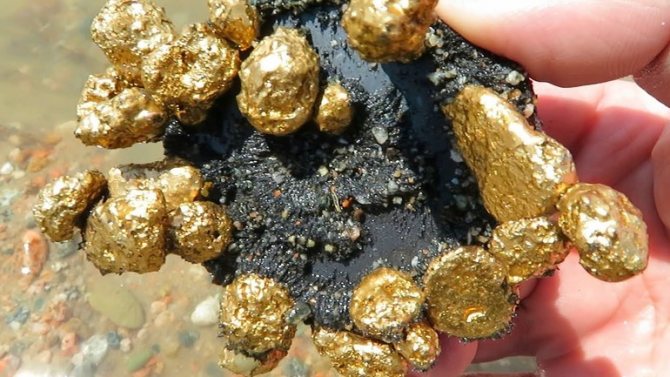
In its pure form, gold is extremely rare, especially when it comes to stones containing this noble metal. In most cases, yellow treasure is found along with various impurities that need careful processing. It is possible to find pure material in large quantities in quartz formations. Such formations are constantly exposed to wind and rain, which causes their destruction. As a result of this process, a single piece of gold nugget is formed.
Natural reserves of gold are also contained in the following deposits:
- Eluvial.
- Residual.
- Bottom.
- Terraced.
Residual deposits are observed near the vein itself, which was under physical or chemical influence. The eluvial type is found directly at the foot of the mountains.
Terrace deposits can be identified at the bottom of reservoirs, usually rivers, which erode the earth, forming an additional bottom. The old bottom layer turns out to be above ground level, which makes it look like a kind of terrace. And the older this terrace, the higher the likelihood of successfully identifying a large number of valuable reserves. Sediments end up at the bottom through precipitation, and under the influence of rain and currents they are washed ashore.
Where to find golden treasures?
The reserves of this precious metal in nature are not endless, but the earth still shares it with humanity. Although large known deposits have long been depleted, many small ones remain where gold is difficult to find, but possible. Deposits where work was carried out during Soviet times are popular among prospectors. They are usually processed industrially, so there is a high probability of finding gold in the stone in large quantities.
There are two types of gold deposits - primary and placer. The main gold reserve is located in the bowels of the earth. It reaches the surface only as a result of volcanic eruptions.
The main source of rocks in which gold is found is solidified magma. Over time, it cracks and breaks up into individual stones. Often, in addition to metals and other chemical elements, stones contain gold in quantities that justify its extraction. The name of these wonderful stones is gold ore.
Deposits of stones with a high gold content, not discovered by miners in time, are exposed to changing weather conditions. Rain, snow, frost, and wind gradually destroy the structure of the stone and lead to the natural separation of gold particles from other chemical elements. Rain streams carry the precious metal into the beds of mountain rivers. These are the so-called alluvial deposits; it is in the floodplains of rivers that prospectors have long been panning for gold using ordinary trays.
About gold in nature
In fact, gold is found in completely different places:
- in plants - its presence in the ashes signals a gold deposit in the place where they grow;
- in sea and ocean water – production is possible, but too expensive and therefore unprofitable;
- in stones - there is gold in almost all rocks, most often its content is negligible, but sometimes there are whole placers of stones with a high content of the precious metal.
The main satellites of the precious metal are quartz rocks and sulfide ores.
The discovery of such stones signals that the search will soon be crowned with success. There is gold-containing granite; it is quite difficult to extract metal from this stone.
Gold miners know that by law, a stone containing gold must be transferred to a state-owned enterprise for refining.
Extraction methods
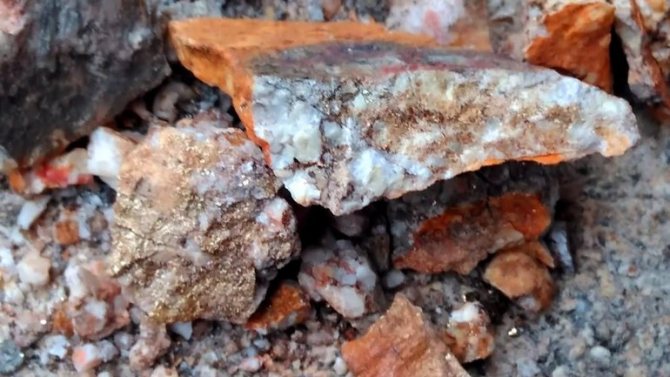
One of the oldest, but also the most dangerous methods for extracting gold from stones is amalgamation. Today, the technique is officially prohibited in the Russian Federation, but continues to be in demand in other countries, as well as among “black” miners. To extract the precious metal, mercury is used, which is placed in a plastic or glass tray with existing sand and the smallest fractions of the yellow treasure.
It is known that mercury is not able to dissolve gold, but can draw it into its balls. To speed up the process, the gold miner regularly turns the tray, allowing the substance to roll completely over its entire surface.
Mercury beads combined with gold are called amalgam . After separating such a mixture from the sand, it is additionally treated with hydrochloric acid, which promotes the dissolution of mercury, but has no effect on gold. The method of evaporating toxic mercury under the influence of fire is also practiced. Similar manipulations were carried out directly in the frying pan. Once in the acid, the gold settles to the bottom in the form of flakes, after which it is subjected to deep washing. If you want to preserve mercury for further operations, a piece of foil is lowered into the acid. Thus, the mercury precipitates.
The next method of gold extraction, known since ancient times, is panning. Unlike the previous method, washing is considered completely safe for the body and does not harm the environment. The method is based on the special properties of the precious metal, namely its high density. Flushing is relevant for both industrial and private mining. It also continues to be practiced in placer deposits.
The technological process itself consists of washing the sand with water, as a result of which the light fractions are quickly removed, while the heavy fractions remain at the bottom. The disadvantage of this technique is that too small particles are washed out by water, which significantly reduces production productivity. When wondering whether it is possible to engage in private gold mining in this way, you need to pay attention to the relevant law. It involves the purchase of a prospector's license valid for up to five years.
Home techniques
Industrial gold mining differs significantly from private gold mining, and the methods used have many advantages. If you know how to identify gold in a stone, you can successfully remove it from there using the most primitive methods.
And you don’t have to go to distant Siberia in search of abandoned mines. You can implement the idea of withdrawing precious metals at home. Back in the days of the Soviet Union, skilled craftsmen extracted it from old watches and other yellow metal products. In the recent past, gold plating was present on many radio components and household appliances, which was justified by its practicality and resistance to corrosion. Without a doubt, the percentage of gold content in such objects is negligible, but in the rock it is not that high.
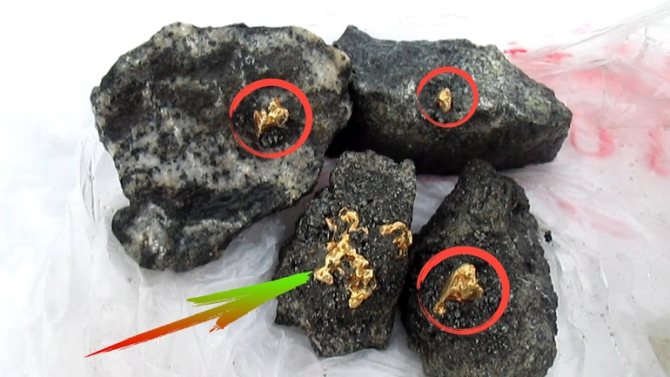
If you want to get the precious yellow material at home, just take an old wristwatch and then fill it with nitric acid in glass or plastic containers. The substance will quickly dissolve any materials except gold. The resulting solution must be carefully passed through several layers of gauze, and the seized gold must be infused in vodka for 24 hours. This will result in a brownish tint.
In the future, it is necessary to rinse the composition with plain water, filter again and put on low heat to melt. To improve the efficiency of the latter process, soda is added to the gold. We must not forget about the ability of the yellow metal to evaporate, but through melting it is cleared of excess impurities and becomes like a tiny ingot.
Gold can also be extracted from radio components , in which it was used back in the Soviet Union due to its inertness and minimal electrical conductivity. To implement such an idea, you need to use “regia vodka”, which consists of nitric and hydrochloric acid. Such a substance can dissolve gold at room temperature. By the way, there are historical facts about the dissolution of gold medals in order to hide them from the fascist military. Under the influence of aqua regia, gold precipitates, after which it is thoroughly filtered and washed.
General description of dangerous rocks
Oddly enough, all poisonous and radioactive minerals are attractive in appearance, distinguished by a variety of shades and unusual beauty. They attract with their brightness and richness of colors, attracting the eyes of lovers of beauty. But you should treat them with extreme caution, since their presence in close proximity can lead to negative consequences, including death.
You need to know this information, but you shouldn’t worry too much. In the vastness of Russia, such stones are very rare. Usually they are present in those developments and mines where the average person is “not allowed to enter.” As for world resorts, before they are officially declared recreation areas, a thorough study of the local flora and fauna is carried out for the presence of dangerous objects. If such items are detected, the service personnel are obliged to warn all vacationers about this.
Galena
In appearance, it can be classified as “high-tech” style. It is very unusual and is quite rare in nature. Galena is the main ore for lead mining. In its structure, this mineral resembles small shiny silver cubes with unique symmetry and clearly defined shapes. At first glance, it seems that this is not a creation of the Earth, but the creation of an artificial stone in a laboratory.

The presence of a steel color with a delicate bluish tint is reminiscent of the endless Universe. But, despite its beauty, this gem is quite dangerous for humans. Even if you spend some time in his company, incurable diseases appear over time. Mostly those who belong to the category of amateur naturalists suffer from this mineral. These are, as a rule, amateurs who are carried away by external beauty, without thinking about the properties and mortal danger associated with it.
The danger of this natural creation lies in the fact that it captivates so much that there is a desire to constantly deal with it, study, explore, experiment, in general, not to let it out of your hands. For example, if you hit it with a hard object, it will crumble into many small particles, like two drops of water similar to the original specimen. Such “miracles” attract people for a long time and force them to hold it in their hands, which subsequently negatively affects human health.
Knowledgeable people prefer to stay away from such a beautiful gem or take safety measures. Thus, miners who regularly come into contact with galena, after a short time, are diagnosed with severe occupational diseases, which are a consequence of toxic dust entering the respiratory tract.
Torburnite
People call it "hell's stone." And this is no accident, since its properties resemble uranium. It contains phosphorus, copper, water and uranium. It looks beautiful: many small bright green prisms are concentrated on its surface. He beckons with his attractiveness and makes you linger for a long time near him. But there is a serious danger in torburnite and it lies in the fact that this gem can emit radon gas, which is considered deadly to humans. It causes lung cancer.
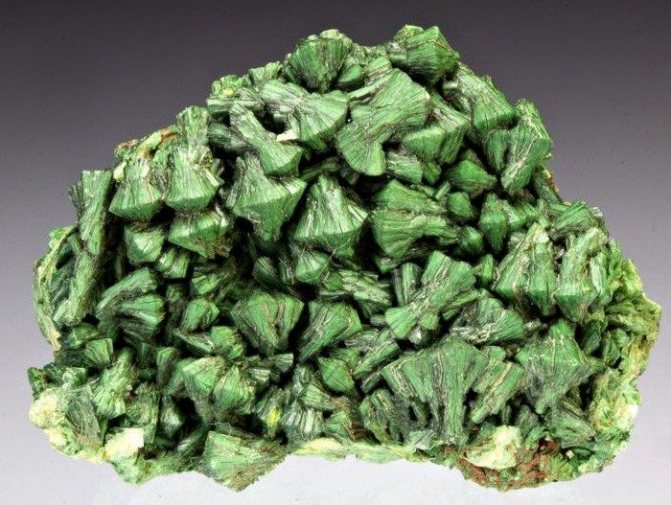
Due to the presence of a large amount of uranium component in the stone, it is possible to determine the presence of uranium deposits in a particular area. But ordinary people shouldn’t worry too much, since you simply won’t see him on the street. But it can be dangerous due to such a popular finishing material in the construction industry as granite. Before purchasing natural granite slabs for your construction, you need to make sure that there are no rich green inclusions in it. They may be torbernite.
The stone owes its name to the famous Swedish chemist and mineralogist Thorbern Bergman. The main deposits of this mineral are located in the UK, Czech Republic, Germany, Poland, France, South Africa, and the USA.
Coloradoite
It was discovered relatively recently in the United States, in the state of Colorado, inside igneous rocks. And literally immediately the danger was identified in it. It contains mercury and tellurium, which is considered a poisonous element. Therefore, the danger of mercury has actually been increased several times. This stone is so dangerous that you can die from its touch. Its excessive toxicity is off the charts. If the bright sun is shining outside and the temperature is high enough, then it is forbidden to even approach this gem.
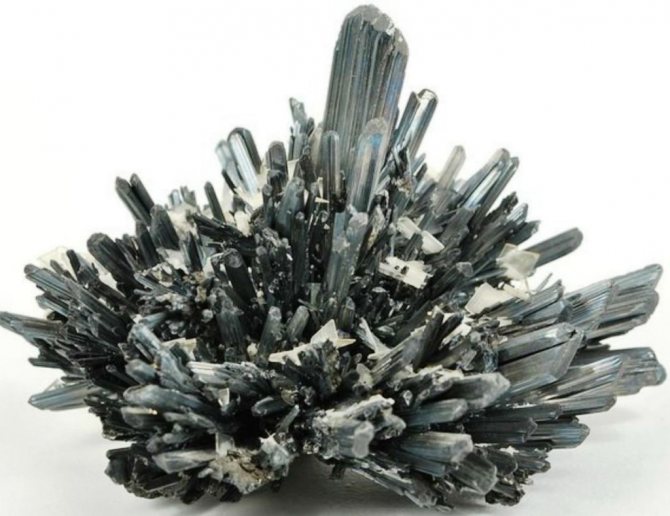
As usual, everything dangerous is very attractive. In its appearance, coloradoite resembles mercury balls, which have a metallic tint, are bright and shining. It is worth noting that the second component of the stone, tellurium, contains gold, which became known during the gold rush in Australia.
Chalcanite
So beautiful that when you meet him, you can’t help but stop. It stands out from many of its fellows due to the beauty of its shade and resemblance to a flower. The presence of a juicy blue-ultramarine hue does not leave anyone indifferent. And its name “Chalcanthit” translated from ancient Greek means “flower”.
Why is this mineral dangerous? With its components. It contains sulfur, water and copper. This mixture is very toxic. The danger lies in the fact that copper, which is considered beneficial for the human body in small doses, quite easily dissolves in water and can be absorbed into any biological body. Excessive doses of copper are very toxic and can disrupt the functioning of internal organs in a short time, which will invariably lead to chronic diseases, and perhaps even death. If it so happens that you hold this mineral in your palms, then you should immediately wash your hands with soap and running water. If you bring the gem to your lips, you cannot avoid poisoning.
How were the dangerous properties of this stone revealed? Young mineralogists, to determine the presence of salt in chalcanite, tasted it. Then the typical symptoms of poisoning appeared. This is how the danger of this mineral was revealed. It was noticed that signs of environmental disaster appeared in the places where this stone was mined. If deposits were found in water bodies, then fish and plants died there, and all living microorganisms disappeared. On the territory of Russia, chalcanite is found in copper ore deposits of Nizhny Tagil, Transcaucasia and the Middle Urals.
Asbestos
A well-known natural stone that has successfully found its application in construction, automotive industry, and rocket science. But at its core, it is a rather dangerous toxic mineral, which under certain circumstances can have a negative impact on human health.
It is worth noting that it has no toxicity. But microscopic particles of asbestos crystals are easily transported by air masses and can enter the human lungs. Once ingested, they harden and cause irreparable damage to the thin walls of the lungs, forming scars on them. This can cause chronic diseases with negative consequences.
The mineral looks quite attractive. Its deposits can be found in Russia, Italy, Brazil, Canada, France, and South Africa. But the extraction of this dangerous stone is carried out taking into account all safety regulations.
Stibnite
In appearance it resembles arrows collected in one bunch, sticking out in different directions. It has a silvery tint and is found in most antimony deposits. In ancient times, when large crystalline formations of stibnite were found, it was used to make beautiful dishes. But over time, it became clear that such an element of household utensils could kill.
Currently, collectors use a separate case with a well-closing lid to contain stibnite crystals. Large accumulations of this gem were found in Japan. Samples of arrows 30 centimeters long were found there.
Hutchinsonite
Beautiful to look at, but fraught with incredible danger. This mineral contains lead, thallium and arsenic. If this composition enters the human body or any other living creature, instant death is possible. Despite its beauty, it is strictly forbidden to touch Hutchinsonite with your hands! And the miners who extract this gem are well aware of this.
The main deposits of this gem are located in European countries. It owes its name to the famous British mineralogist John Hutchinson. It is worth noting that thallium, which is part of it, is more dangerous than lead. Thallium is considered a heavy and very toxic substance, which even in small quantities can cause hair loss, skin disease, and even death.
Arsenopyrite
Among experts it is usually called “fool’s gold.” This stone is very similar in appearance to gold, but holding it a little in your palms can cause you to die. If you translate the name “Arsenicum” from Latin, you get “arsenic”. Arsenopyrites are also given another name - “arsenic pyrites”.
The mineral is very similar to a gold nugget and is found quite often in nature. It can be seen in the composition of fluorite and quartz rocks. Until recently, miners died en masse from the ingestion of arsenopyrite. But the heated mineral is considered the most dangerous. Its vapors are so toxic that if they enter the lungs, they can cause death. Determining arsenic is quite simple. You need to hit a pebble with a hard object and a lot of sparks will fall, emitting a pungent garlic smell.
Orpiment
There may be a more dangerous option than arsenic. This is the so-called “arsenic stone”, which received its official name “orpiment”. This mineral contains sulfur, which is found near geothermal springs. Like most poisonous stones, this gem is beautiful in appearance and makes you admire it for a long time, even hold it in your hands. But this is strictly prohibited, since the incredibly carcinogenic and neurotoxic arsenic can play a cruel joke on you.
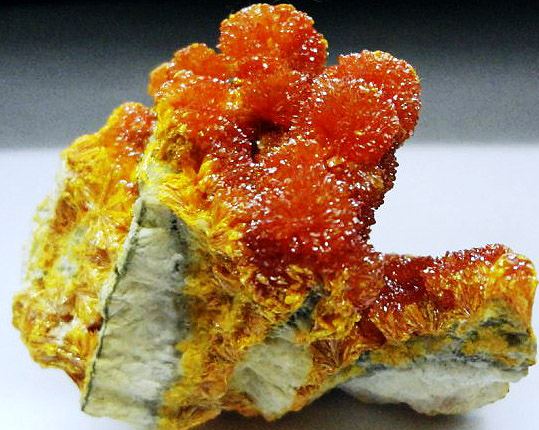
This mineral is closely related to the history of Ancient China. They used this gem for the same purpose as cinnabar. The consequences were terrifying. Orpiment was part of the ocher paints used by brush masters, which is why they died early. But this is not the only use of “arsenic stone”. It was crushed to a powdery state and introduced into a certain composition, which was used to lubricate arrowheads. In this way, the enemies of the Celestial Empire were sent to the forefathers. But those people who treated the arrows with this deadly compound did not escape death.
Cinnabar
It is mercury sulfide and is one of the most toxic minerals involved in the processing process. This mineral is popularly called “dragon’s blood.” Cinnabar ore is the basis for mercury mining. Its formations are found in the immediate vicinity of volcanoes and sulfur deposits, and the presence of bright red crystals indicates the presence of a mortal danger.
Mercury is released when cinnabar is heated to a certain temperature, and if at this time a person is in the immediate vicinity of this process, then he will experience convulsions, loss of sensitivity and then death. In the 17th century, if a person was sent to mine minerals in Spanish mines, it was considered a death sentence. From there, as a rule, no one returned alive.
Despite all the warnings, in the Celestial Empire decorative dishes for eating were made from cinnabar. Its large crystal formations were used to create intricate crafts that sometimes cost skilled craftsmen their lives. There were also would-be healers who prescribed cinnabar powder to patients to cure many diseases.
Uranite
The very name of the mineral indicates that its composition contains uranium (88%), actinium, radium, polonium and other elements that are obtained during the process of radioactive decay. The crystals are rhombic dodecahedral, octahedral, cubic formations of black, greenish-black or violet with a waxy, greasy or matte luster.
In general, uraninite is the basis of uranium ores and is too radioactive. It is very dangerous to people's health and it is better not to deal with it.
Kuprosklodovskite
Like the previous representative of the world of minerals, kuprosklodovskite is related to uranium deposits and is extremely radioactive. Not only should you not pick it up, but also not approach it at close range.
This gem is quite rare and belongs to the group of hydrous uranyl copper silicates. In appearance, it is somewhat reminiscent of sklodovskite, but its distinctive feature is its specific yellow-green color, which attracts the attention of beauty lovers. Crystals with a glassy or silky sheen are translucent.
Otenitis
It is also called “uranium mica”. It is a mineral, belongs to aqueous calcium uranyl phosphates, and is a representative of the otenite group of the uranium mica family. The main deposits of the gem are considered to be the Czech Republic, England, Germany, France, the USA, and Madagascar. Small deposits are located in Australia and Portugal, as well as on the Cornwall peninsula.
The uniqueness of this natural stone is that in the absence of light it can phosphorize, because its composition is half uranium. It is uranium that makes it radioactive and very dangerous to human life and health.
Studtit
Belongs to the category of rare secondary uranium minerals. It forms as growths on other minerals, usually uraninite and uranophane. Can be found in oxidized uranium deposits. Studtite was detected on the surface of nuclear waste after long-term storage, as well as on the products of the reactor explosion at the Chernobyl nuclear power plant.
Crystalline formations have a light yellow or yellow tint with a pale yellow streak, glassy, silky or waxy luster. They are translucent or transparent in appearance, have minimal hardness, and are quite fragile.
This mineral was discovered in 1947, and received its name in honor of the English geologist and prospector Franz Edward Studt. It is found infrequently in nature and is not commercially mined. It is considered radioactive, and therefore poses a danger to humans.
Curite
It is a secondary mineral containing uranium and lead. It dissolves well in acids and can change color when exposed to ultraviolet rays. The presence of strong radioactivity was detected.
Curite crystals are quite attractive. They are red-brown or orange-yellow in color with a diamond or matte coating, translucent in the light, and quite hard. There are dark yellow specimens with the same characteristics.
Lepersonnite (Gd)
It has a rather complex composition and belongs to aqueous uranite-carbonates containing SiO4. It is secondary and can be found in oxidation zones of uranium deposits. It looks as beautiful as it does dangerous. It has too much radioactivity.
The crystals are predominantly yellow in color with light yellow streaks. They have a glassy or silky sheen, the formations are translucent or transparent.
Ouranophanes
A highly radioactive mineral, contact with which can be fatal. But it is not possible to meet it in ordinary nature. It has prismatic or needle-shaped crystals with a yellow or lemon yellow tint. It has a glassy or waxy sheen and is highly translucent.
Realgar
Its danger lies in its composition: arsenic and sulfur. This mineral was known in ancient times and was used as an ingredient for dyes. In the modern world, it is used to make arsenic acid, as well as paints and pyrotechnics.
Realgar is most often found in low-temperature hydrothermal veins. Its companions are stibnite and orpiment. Fine specimens of considerable size have been found in Sweden. Deposits of this gem are located in Georgia, the North Caucasus, Kyrgyzstan, the USA, Japan, China, Greece, Romania and Russia.
Under the influence of sunlight, the mineral is destroyed, resulting in the formation of a yellow-orange powder, which consists of pararealgar, arsenolite, and orpiment, so it is impossible to find it in its pure form on the surface.
In appearance, the realgar is very beautiful. Its transparent orange-red, bright red and dark red crystals with a greasy or resinous sheen are impressive.
Celestine
A very soft stone that was discovered at the end of the 18th century in Sicily. The name of this mineral was influenced by its beautiful bluish (heavenly) color. It contains barium and calcium. Celestine is used as a strontium ore. In their appearance, the crystals resemble celestial towers, because they have the shape of tetrahedral pyramids with sharp ends. In stores you can find beautiful crafts made from celestite. Rarely found as jewelry.
It is worth noting that celestine was used by magicians in their rituals. He was also endowed with certain magical qualities. It was believed that this mineral was completely safe for the health of others. But this is far from true. Of course, no one died immediately after contact with celestine. But the negative consequences of such contact appeared after a long time, and, of course, no one connected this event with the stone.
Zircon
The most ancient representative of the world of stones. Its estimated age is about 4 billion years. It has a unique shine and color range. Zircon belongs to the category of precious minerals and is highly valued by lovers of the beautiful and unusual. It stands on the same level with such precious stones as diamond, topaz, citrine, ruby and sapphire.
There are plenty of places on the planet where this unique mineral is mined. These are Russia, Korea, Australia, Thailand, Vietnam, Brazil, Cambodia, Norway, Tanzania, Vietnam, Sri Lanka, Nigeria, Madagascar. This mineral was credited with both medicinal and magical properties. For example, it was believed that blue gems could eliminate intestinal problems, and brown gems protected against viral and colds. Red crystals helped in love and mutual understanding, strengthened family ties. Yellow calmed, set the mood for positivity, protected from hatred, anger and irritability, and promoted clarity of thought.

Zircon is used to create beautiful jewelry. These can be rings, bracelets, necklaces, pendants, pendants, cufflinks and so on. They are beautiful and affordable. But you shouldn't buy this beauty on the black market. You may encounter radioactive specimens, and not everyone has dosimeters. Try to give preference to specialized retail outlets selling jewelry, where all goods undergo preliminary inspection and the necessary research.
Heliodor
It resembles the radiance of the sun, so if you translate its name from Greek, you get “solar gift.” Its color range is impressive: from light gold to dark honey. It was believed that if heliodor was found, happiness would never leave such an owner. His life will be full, wealth and prosperity will never leave his family, the children will be happy.
Deposits of this gem are located in Namibia, Russia, Madagascar, and Sri Lanka. Large specimens were recovered from the depths of Ukraine. Its companions are topaz and tourmaline. The largest specimen was heliodor, weighing 2000 carats and 12 centimeters long.
But what is the danger of this mineral? In its parameters. Heliodor contains certain radioactive components, and the larger the crystals, the more radioactivity is manifested. Therefore, before dealing with this beautiful gem, you should make sure that it is safe for health.
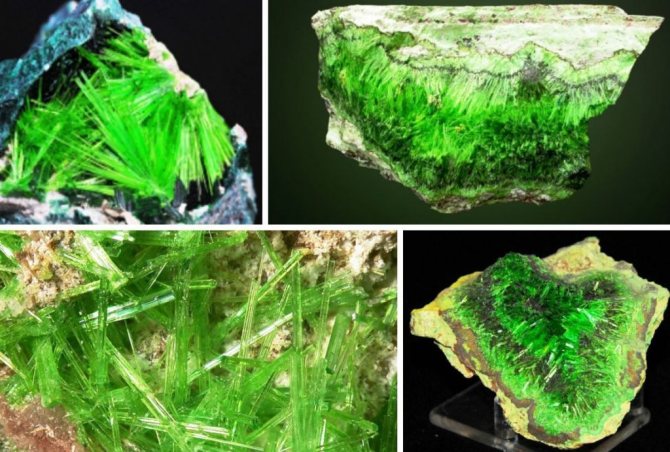
Historical facts
If you familiarize yourself with historical facts, you will know that during the times of Ancient Rus', the state had practically no gold deposits, despite its vast area. Prince Ivan III devoted a significant part of his life to the issue of searching for precious metals, because he was practically obsessed with the idea of \u200b\u200bsearching for treasures. To realize his dream, he even invited Italian specialists and allocated impressive sums. But the efforts were not justified; he managed to find only a small piece of gold, which was only enough to make a tiny cross.
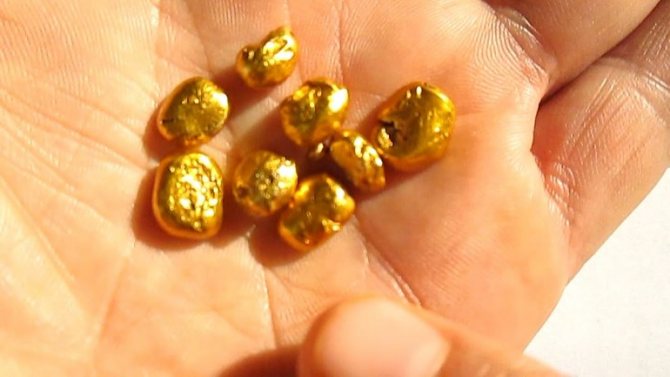
After him, Ivan the Terrible began to actively search for yellow sand. To find the valuable metal, he even went to war against the Siberian settlements, but was also doomed to failure. A similar story happened with the rest of the rulers of Ancient Rus', until a turning point in the history of the state occurred. This was the rise to power of Peter I. The legendary ruler began to actively introduce clothing items and jewelry containing precious metals and valuable stones.
The first gold nugget was mined by a Ural peasant in 1945. This happened spontaneously while digging a hole. The happy owner of the precious stone immediately showed the find to a friend, who turned out to be a silversmith and confirmed the authenticity of the nugget.
The place where the find was discovered immediately attracted the attention of specialists, which led to the start of numerous search operations. However, they were unable to find anything, so work was suspended. Soon the authorities decided to resume the search and equip the mine. This decision paid off. At the bottom of the dug mine there was an impressive amount of gold reserves, which became the basis for large-scale gold mining.
Since ancient times, people have been interested in the idea of mining gold at home. Today, this trend is no less popular, only the methods of its implementation have changed significantly. Of course, you won’t be able to get rich through private gold mining, but finding a new hobby, as well as a little extra income, is quite possible.




